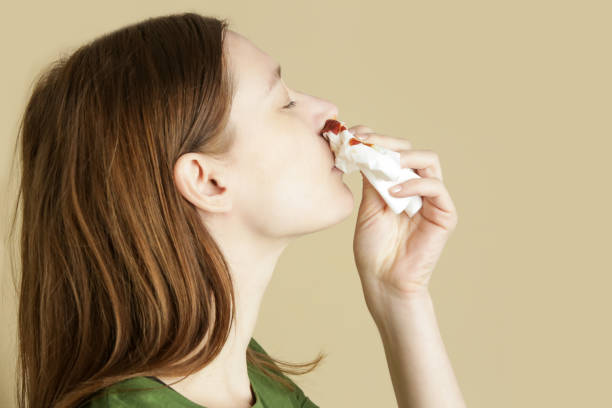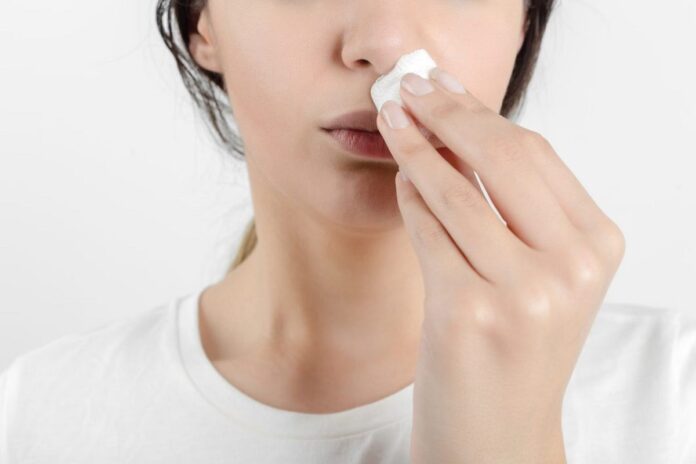Known by the medical term epistaxis, nosebleeds are quite common. It’s estimated that about 60 percent of the population will have a nosebleed at some point in their lifetime, and about one-tenth of them will need to seek professional medical care for it.
The majority of nosebleeds occur in the forward (anterior) part of the nose, especially on the septum, or the structure that internally divides the nostrils. This area is home to a rich network of blood vessels that are more likely to be injured with fingernails or other trauma, and it has fragile membranes that easily dry out. In people past middle age, however, nosebleeds more commonly occur in the posterior (back) part of the nose. This type of nosebleed is harder to stop.
Table of Contents
Who gets nosebleeds?

Two age groups are the most likely to experience nosebleeds: young children and people over age 45. Nosebleeds are also common among pregnant women, who are about three times as likely to be affected as women who are not pregnant.
What causes nosebleeds?
Dry air—whether outdoors, on a plane, or at home—may make the mucus membranes in the nose more susceptible to injury and, therefore, more likely to easily bleed. Some research has linked low humidity with an increase in nosebleeds. However, there’s inconsistent evidence as to whether temperature affects nosebleeds.
Also Read: Hemophobia or Fear of Blood
Inflammation from a cold, allergies, or sinusitis can lead to a nosebleed, possibly by causing tissues to swell in the nose. Picking your nose or blowing your nose hard can set off a nosebleed; so can hard rubbing of your nose and, of course, a bump or blow.
Some medications increase the risk of nosebleeds, including antihistamine nasal sprays and drugs that decrease blood clotting, such as warfarin. (It’s unclear whether aspirin, which also decreases clotting, increases nosebleed risk.) Corticosteroid nasal sprays may also increase the risk, by causing trauma inside the nose. Garlic, ginseng, and other blood-thinning herbs, as well as ginkgo and ginseng, may also contribute to nosebleeds.
Nosebleeds are sometimes attributed to high blood pressure, but the relationship between the two remains unclear. In pregnant women, nosebleeds may be due to hormonal changes that affect the blood vessels in the nasal passage.
Immediate care for nosebleeds
Most nosebleeds will stop spontaneously or with the application of simple remedies. The following measures usually stop a nosebleed quickly:
- Sit up. This allows gravity to reduce pressure in the veins of the nose. To keep blood from running back into the throat, lean forward and tilt your head down a little.
- Pinch the fleshy part of the nose. This is the part between the bridge and the nostril. Pinch with your thumb and index finger for 5 to 10 minutes, breathing through your mouth. Applying ice probably won’t help, since it’s really pressure, not temperature, that stops the bleeding.
- One method emergency room doctors use to treat nosebleeds (that you can also try) is spraying the decongestant oxymetazoline (Afrin), which rapidly constricts blood vessels, into your nose on the affected side, then pinching your nostrils closed for 15 to 20 minutes. This technique has been found to be successful in large percentages of people who come to ERs for nosebleeds. Decongestant sprays have risks, however, and you should talk with your physician before using them if you have kidney or liver disease, diabetes, thyroid problems, hypertension, or a history of stroke.
- Consider using an OTC product that can stop bleeding on contact. One such product, called NasalCease, is made of a material derived from seaweed.
Once the bleeding has stopped, try to limit or avoid blowing your nose for at least a week, since it may cause the bleeding to restart. You can also use saline nasal spray several times a day to keep the mucus membranes moist during this time.
When to seek medical care
Recommendations vary, but in general, you should go to an emergency room if you’ve had a nosebleed that lasts longer than 20 minutes or so after applying home treatment, if blood is continuing to drain down the throat from the back of the nose, if you feel faint, or if you have recurrent hard-to-control bleeding. If you have frequent nosebleeds or difficulty stopping them, you may be referred to an ear, nose, and throat (ENT) doctor.
For anterior bleeding, if pinching your nose hasn’t worked, the doctor might try cautery, in which silver nitrate or an electric current is used to close off (cauterize) blood vessels. If this isn’t effective, doctors will sometimes pack the nasal passage with gauze or insert a small inflatable balloon to stop the bleeding; however, patients often find these methods uncomfortable, and they can also cause further trauma and infection. More recent—and more comfortable—techniques include inserting absorbable gels, glue, or gauze that enhance clotting.
For posterior nosebleeds, the doctor may also try irrigating the nasal passage with warm water. (This might work because the temperature causes the tissues to swell, compressing the blood vessels.)
How to prevent nosebleeds
- If you must use an antihistamine or corticosteroid nasal spray because of allergies or a viral infection, it’s suggested you angle the nozzle away from the nasal septum, by, for as in spraying the drug into your left nostril with your right hand and vice versa.
- Avoid repeatedly rubbing or picking your nose.
- If necessary, softly blow your nose.
- A saline nasal spray can be a good moisturizer, especially in a plane cabin or other dry environment. Or you can use an OTC water-based nasal gel or mist, such as Rhinase. According to a study in the Journal of the American Medical Association in September 2016, people with chronic nosebleeds may benefit as much from using simple saline spray as from prescription drugs commonly used to prevent nosebleeds.
- As a traditional alternative, you can try using a pea-size dab of petroleum jelly just inside your nostrils to keep membranes moist. Apply it with your fingertip or a small cotton swab. But avoid prolonged or excessive use, which in rare cases has been associated with lung damage from inhaling the petroleum particles. Normally the jelly drains down the back of the nose along with nasal secretions and is safely swallowed and excreted. But you can inhale small amounts into the windpipe and lungs, especially while you’re sleeping, when you are unaware of it and don’t cough it up. Over months it can accumulate in the lungs, which can lead to inflammation and possibly even scarring.
- Boost humidity at home. If you have a history of nosebleeds, it may help to use a humidifier to keep the air from becoming too dry.




